Key points from this article:
- Deforestation and the charcoal trade are both harmful to Somalia.
- A recent Somali study has shown that the forest cover loss was due to human activities.
- Historically Somalis have relied heavily on the natural landscape
- Reforestation efforts have begun and we need to support it.
- The charcoal trade is illegal and has been banned internationally and by local communities.
- The charcoal trade funds the activities of Al Shabab.
Why are forests important?
Forest cover refers to the area of land covered by trees. Currently about 10.8% of Somalia is forested, but between the 1990-2010 Somalia lost 18.5% of its forest cover (almost 1% per year was lost). Although half of the entire world’s forest cover has been lost since the 1850s due to human activities, the deforestation of Somalia is especially serious for multiple reasons. These include the limited number of forested areas in the country, the recurring droughts in the region affecting ecosystems, and the heavy reliance on vegetation cover for the livelihoods of Somalia’s pastoral communities.
Forests are essential for our survival, here are some simplified explanations why:
- Trees “sweat” and cool down the temperature: When water evaporates from the tree leaves in a process called transpiration, it takes away some of the heat from the air around it.
- Trees can help make rain! When they release water vapor through their leaves, it goes up into the air. Eventually, that water vapor can turn into clouds and then rain. This process is called evapotranspiration
- Forests absorb the carbon dioxide from the environment, helping us fight against climate change (Harris & Gibbs, 2021)
- Forests are really important for keeping our water clean and our land sturdy.
- They act like natural filters, cleaning up pollutants and stopping soil from washing away thereby keep rivers, lakes, and oceans healthy.
- Forests keep the ground from slipping away on hillsides, so we keep the soil fertile and the land stable.
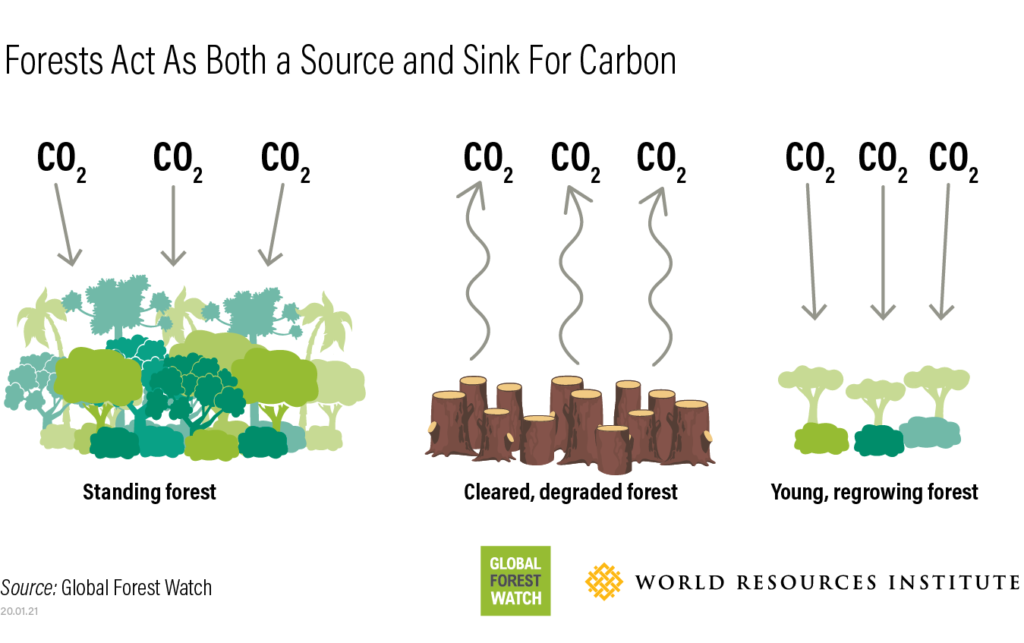
It should therefore be clear why forests are important. So why are we experiencing forest loss? Although there are some natural causes of forest degradation, like wildfires and disease outbreaks, human-driven activities are the main factor contributing to global forest loss.
Deforestation and charcoal
Before diving into the charcoal study below, let’s clarify a few things to give some context. In many developing countries, deforestation is driven significantly by the need for charcoal and fuelwood for energy. Charcoal, produced by heating wood without air, has traditionally been made in pits covered with soil and sand. Production methods evolved to include chimneys made from oil drums for efficiency. Today charcoal stoves are more commonly used.
The majority of Somali households rely on fossil fuels like charcoal (47.9 percent of households) and firewood (41.3 percent) for their cooking needs. In contrast, gas and electricity are used less for cooking. The economic value of the charcoal industry in Sub-Saharan Africa is projected to surpass US$12 billion, providing employment for nearly 12 million people by 2030 (Source).
The favorite tree used for charcoal production in Somalia is the Acacia bussei (FAO-SWALIM) which are now declining rapidly in numbers. The Commiphora trees are also impacted by deforestation.


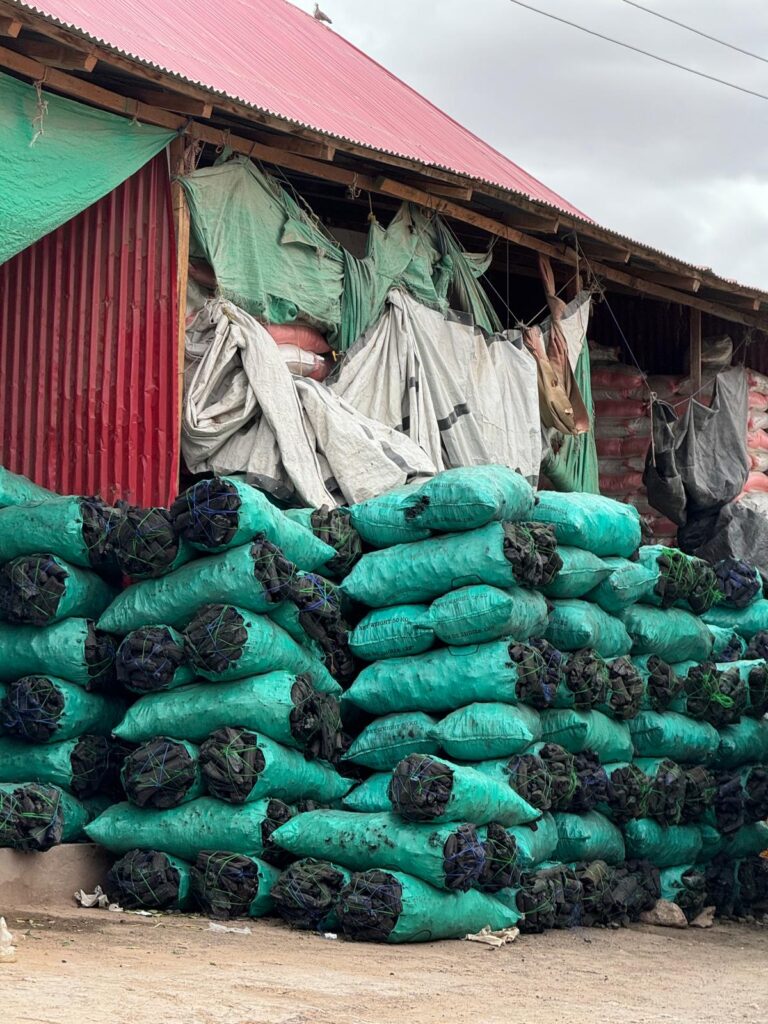
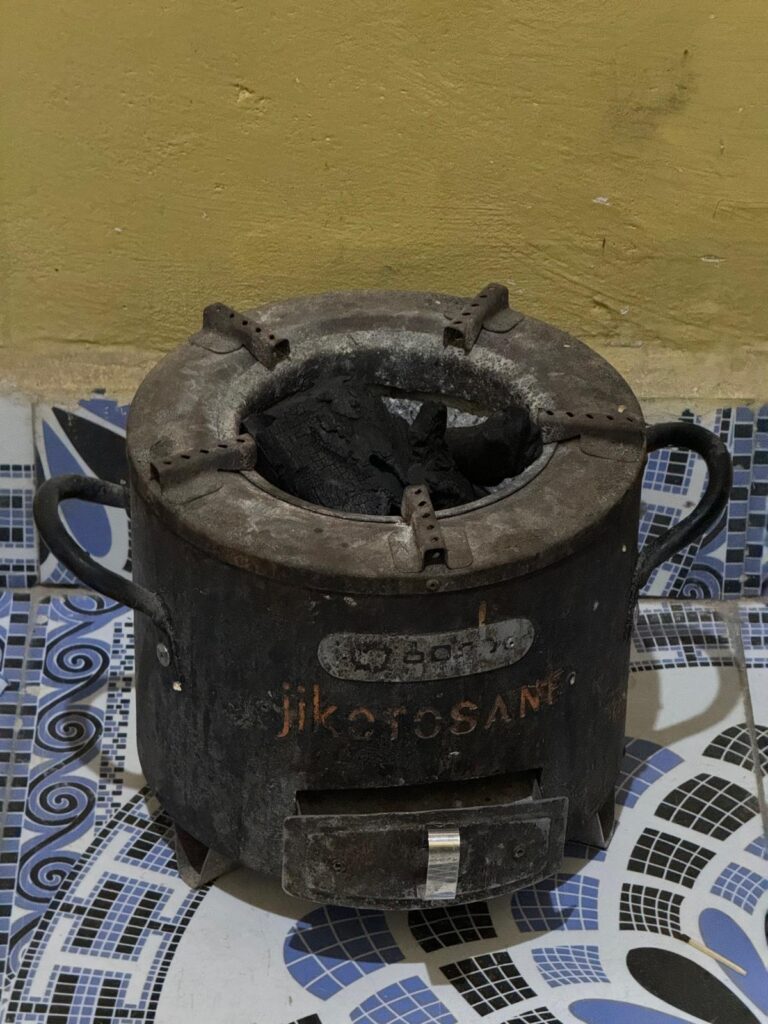
The Somali Study on forest cover loss
Since the state collapse in the early 1990s, Somalia has experienced rampant environmental degradation. This continued pressure on natural resources has severely affected local nomadic populations who rely heavily on the natural landscape for survival. The charcoal production industry, supplying both the domestic market and neighboring gulf states, is the country’s primary stressor of forest ecosystems. It is estimated that over 4.5 million trees are logged to produce 250,000 tons of charcoal annually in the country. These are truly staggering numbers, and the effects of this industry on the forest cover in the country can not be overstated.
Previous studies (Bolognessi et al., 2015; Rembold et al., 2013) have identified charcoal production sites in southern Somalia using high-resolution satellite imagery and mapped the resulting environmental degradation. Consequently, drought is another driver of forest cover change in Somalia with multiple studies (Ogallo et al., 2018; Ramadane, 2014; Thalheimer & Oh, 2023) identifying recurring droughts in the country in 1999, 2008-09, 2011, and 2016-17.
Knowing that both human-caused and natural disturbances affect forest cover in Somalia, I became curious and decided to design a small study to establish if the forest cover change in the country can confidently be attributed to human intervention. The study used Landsat 8 surface reflectance data from 2013-2021 and calculated changes in two band indices: NDVI (Normalized Difference Vegetation Index) and BSI (Bare Soil Index). The area of interest in southern Somalia was around 17,000 km2 in Jubaland state, where most previous studies focused.
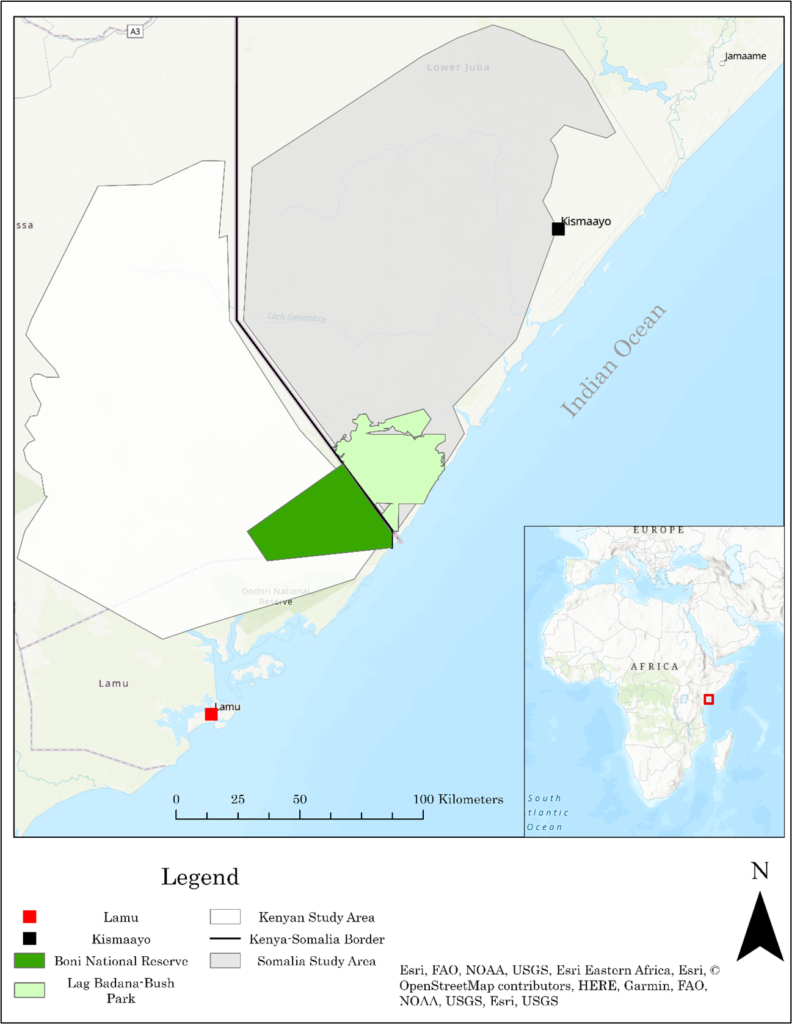
Now, the exciting part. The study area borders Kenya, and there are many similarities between the two regions, whether it be the people, wildlife, climate, or forest cover. I decided to use a similarly sized area across the border as a control area and run an identical analysis for the same time frame. The main differentiating factor between the two regions in this study is government control and the ability to enforce environmental protection laws. If forest cover change is similar in both regions, it would lead to the conclusion that the cause is natural since nature does not recognize political borders the way we do. Therefore, if the results show that the Somali study region experienced more pronounced forest cover loss, some human-driven intervention must be at play!
Some additional background information about the affected area:
1) The area of interest has been under Al Shabab’s control since 2011, and due to their presence, “ground-truthing” (meaning the confirmation of the results from imagery analysis) is impossible. It is well known that Al Shabab has engaged in deforestation activities for charcoal production since their takeover in parts of Jubaland state. Despite the UN Security Council banning charcoal export from Somalia in 2012 under UN resolution 2036, the trade is thriving to the detriment of Somalia’s forest ecosystems. Most of this charcoal finds its way to Kismayo port, where it is exported and provides Al Shabab with consistent cash flow, estimated between $15-$50 million annually, which helps further their regional interests.
2) The advantage of this study is that Northern Kenya is used as a “control” region where the study is replicated. This area is not known for illegal logging due to a stable government that enforces environmental protection to some degree. The border between Somalia and Kenya is political and not recognized by nature. Any significant differences in the results between these neighboring regions can be confidently attributed to humans.
Results
In 2013, the first year of this study, NDVI values (meaning vegetation cover) were, on average, 26% higher in the Somali region than in Kenya. These values were in stark contrast to 2021, the final year of the study, where the Somali region was 5% lower. There was a 34% decrease in NDVI values in the Somali study region from 2013-21, which highlights the gravity of the vegetation cover change that occurred at this time (NDVI figure below). The Kenyan side, on the other hand, did experience some vegetation loss, but at 12%, it was significantly less than the Somali side.
Oddly enough, between 2019 and 2020, the Somali region had a remarkable recovery in forest cover. However, that was all erased in the following year, when it fell to the lowest number recorded in the study. This study employed a mixed-model ANOVA (Analysis of Variance) with a random effect statistical test to determine if the changes observed between regions and within years were significant or not. This statistical test showed significant differences between Kenya and Somalia for every year in the study with a 99% confidence. Using NDVI as an indicator, the results overwhelmingly support the hypothesis that the Somali region in this study, which Al Shabab mainly controls, experienced more forest cover loss between 2013 and 2021 than in Northeastern Kenya.
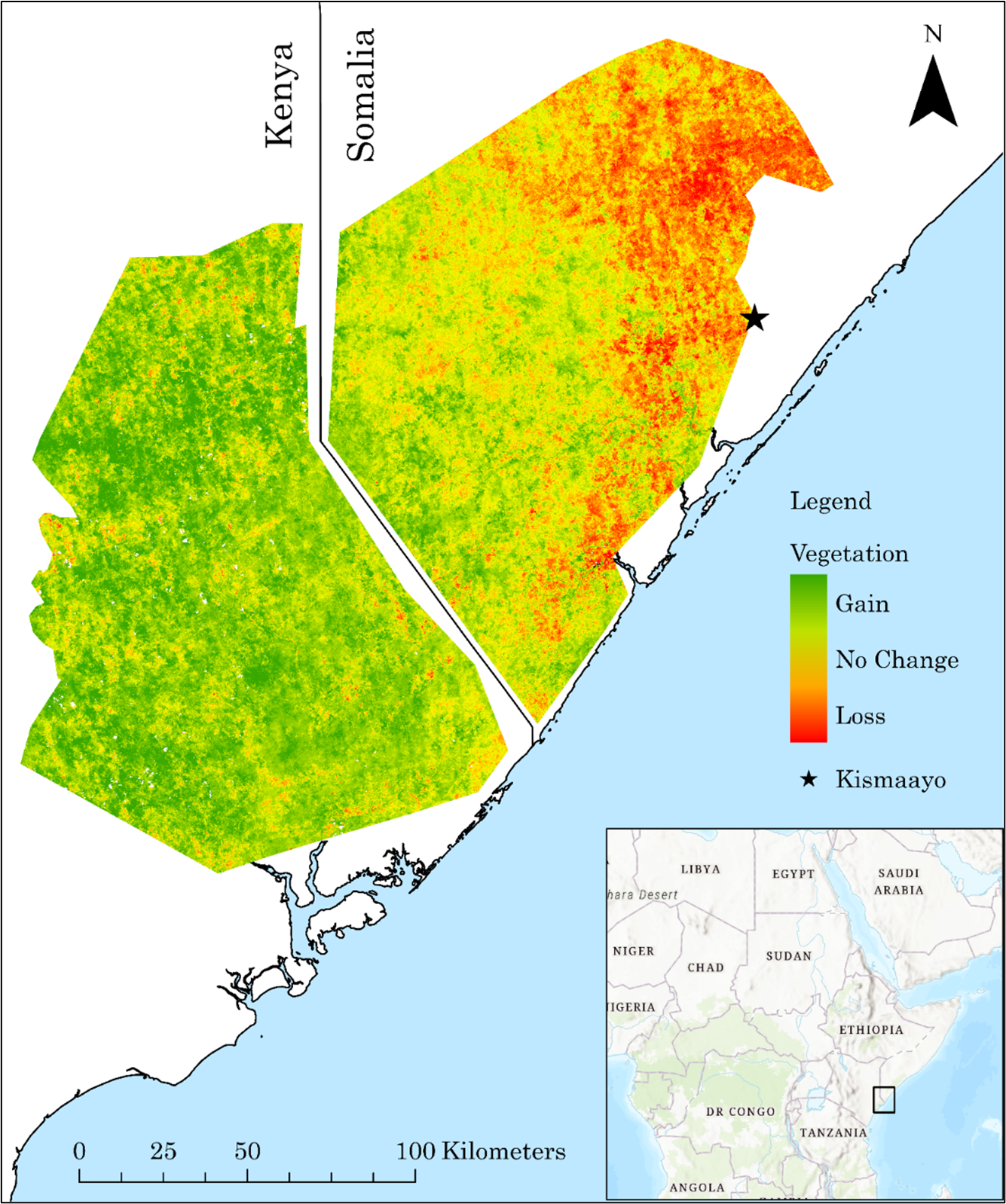
The other indicator used in this study measures the amount of bare soil. Vegetation cover and bare soil indicators have an inverse relationship, meaning if vegetation cover loss is expected, an increase in bare soil can be expected as well. That expectation was valid in this study as well. We mentioned that the Somali region experienced higher vegetation loss before, but it also experienced a more significant increase in bare soil (BSI figure below).
Between 2013 and 2021, average bare soil values increased by 116% in the Somali region, with the highest increase occurring between 2020 and 2021, where it was 89%. Consequently, the Kenyan region experienced a 24% increase in average bare soil values in the same period. These results follow the same pattern as the vegetation indicator, where there were changes in both areas in the study, but the Somali side was much more pronounced. The same ANOVA test was used for the results from the bare soil indicator and, again, confirmed that the differences were significant between Southern Somalia and Northeastern Kenya with a 99% confidence.
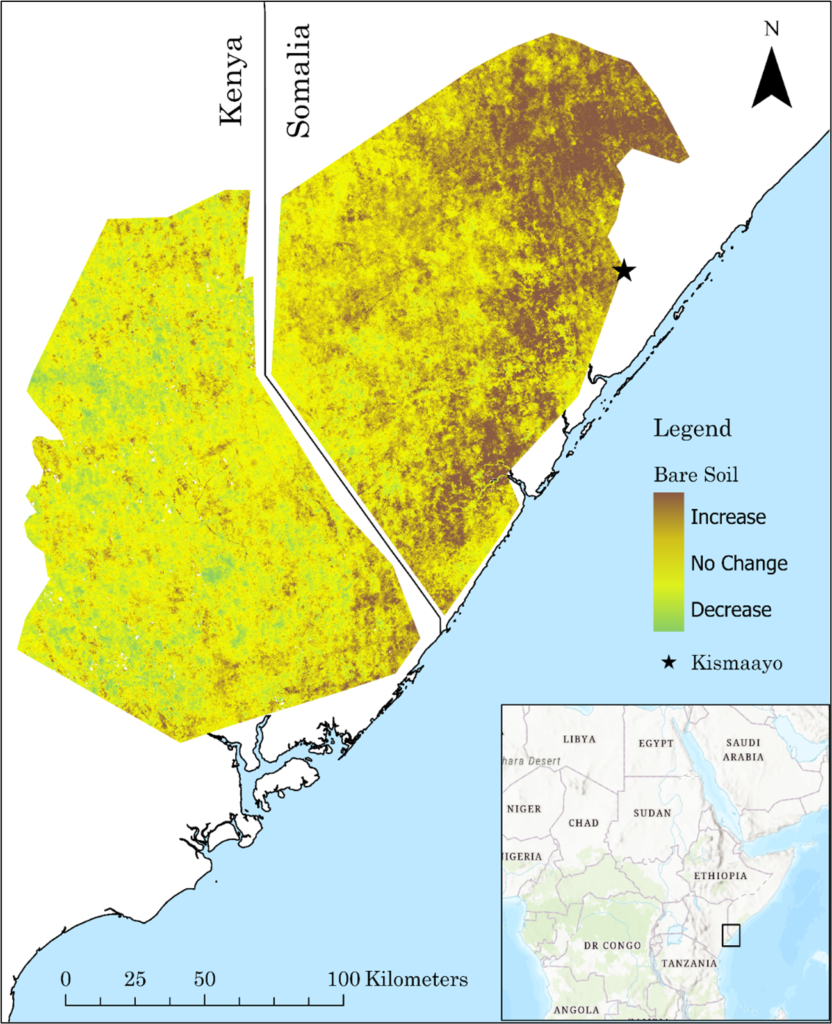
The rural areas surrounding Kismaayo, the transitionary capital of Jubaland state of Somalia, seem to have experienced the highest levels of forest degradation. This observation is evident in the change detection maps from the study above and corroborates findings from previous studies (Bolognesi et al., 2015; Rembold et al., 2013), which identified charcoal production sites in this area. Kismaayo is also the main port used for charcoal export in the country, so it makes sense that areas near there would be exploited first.
The effects of deforestation
Charcoal production significantly increases forest degradation in Somalia and can contribute to soil erosion and desertification (Bolognessi et al., 2015; Warsame & Sarkodie, 2022). These impacts lead to more pronounced climate variability, increasing extreme weather events like floods and droughts (Ogallo et al., 2018).
Environmental modelling predicts Somalia will suffer significantly from climate change, with a significant increase in projected high rainfall extremes and temperature increases (Ogallo et al., 2018). This projection is horrible news for the Somali population and their food security, especially nomadic communities, who suffer the greatest in these conditions. Additionally, Somalia’s environment, particularly vegetation productivity, has been sensitive to changes in temperature and precipitation (Moldenhauer & Lüdeke, 2002).
Somalia has the 2nd lowest CO2 emissions per capita, but the 5% tree-loss between 2001-2022 was equivalent to 973 kt of CO₂ emissions – this is because trees normally absorb the CO₂ in the air. Somalia is also the most climate vulnerable country in the world.
It is not common to hear Somalis talk about how green the southern part of the country used to be before the civil war which began in 1991. Today, we often see images from countless trucks carrying cut down trees for charcoal like in the examples below:
If you simply go to areas around Kismaayo on google earth, you can see examples like this of how an area looks after deforestation:
As a country with nearly 100% Muslims, Somalia needs to practice the Islamic concepts of forest preservation and reforestation as animals and humans eating from the trees we plant is regarded as charity (Sahih Bukhari: 3, 39, 513).
Reforestation
The current president, Hassan Sheikh Mohamud, launched an ambitious tree-planting project in October 2022 together with the Ministry of Environment & Climate Change.
The project, which is called “the national regreening initiative” aims at planting 10 million trees in Somalia. Similar projects are seen worldwide, as deforestation is not limited to any regions of the planet.
We have not been able to get an update on how this project is going. However, while searching we found a Somali organizations actively working towards re-greening Somalia. Read more below.
“Bisha Cagaaran” (green crecent) is re-greening Somalia
None of the issues Somalia is facing are unique – other countries have similar issues and some have already solved them. At MoreSomalia the core belief is that all issues are solvable, and this includes deforestation. Looking for how to solve the serious issue of deforestation in Somalia, we only found 1 organization doing practical work – “Bisha Cagaaran“. We had a call with Abdi who is the founder of the organization.
MoreSomalia: What is the goal of Bisha Cagaaran and how big is the team?
Abdidahir: “Bisha Cagaaran was founded in November 2022 and our main goal is to regreen Somalia and fight against deforestation. All our work is volunteer work and we have no funding. Currently we are the only organization in Somalia who is making serious progress on this issue. We are currently a team of 15 who all volunteer. Our members are based in Somalia, UK, Sweden and the Netherlands. We do not have any funding from organization or the government – we do it all for free and fund everything ourselves.”
MoreSomalia: Tell us about the process and how much progress you have made.
Abdidahir: “We plant the seeds in a big farm in Mogadishu, and once they have grown in our nursery we give them away for free to places that need the trees such as schools, hospitals, public institutions, and even private houses. We focus on planting indigenous/native tree species and last year we planted over 80,000 seeds. The aim right now is 300 seeds per day and have over 330,000 trees growing on the farm – but we have a much larger capacity. We are currently the only organization who have made tangible progress in combating the deforestation”.
Here are a few images from Bisha Cagaaran and their amazing work. If you want to support this great project, they will happily welcome any donations and assistance. They are also doing a huge fundraising in London in October.
Socials: Facebook, Twitter, Website.
Conclusion
The presented charcoal study, performed by a Somali author “Jariiban”, is the first of its kind. From it, we can see clear evidence of human-caused deforestation in areas around Kismayo. This is caused by the charcoal industry, which is harming Somalia’s environment. Cutting down trees in Somalia and illegally exporting it abroad is an unsustainable disservice to the country’s future. Fortunately a lot of recent activism is advocating for improvements, and Bisha Cagaaran is actively working on re-forestation – but we need more hands. Re-forestation only part of the solution, the other part is stopping the charcoal trade. Today, an increasing number of Somali households are moving away from charcoal towards propane tanks. And with the newer and safer plastic containers (rather than the popular metal ones), more people feel safer using them. Subjective estimates in central Somalia say 50% are using gas and 50% charcoal within the cities, and in rural areas only 15-20% use gas while the rest still depend on charcoal for their cooking needs. Nevertheless, the government, with its promise of regreening the country, bears a huge responsibility and the Somali people must hold them accountable.
We need to preserve Somalia’s environment more than ever due to the increasing impacts of climate change in the country. For this we need to protect our forest cover, stop the illegal charcoal trade and transition to better environmental solutions such as gas, and work towards re-greening Somalia. Awareness is the first step – we know now. Practical solutions should follow next.
References
- Bolognesi, M., Vrieling, A., Rembold, F., & Gadain, H. (2015). Rapid mapping and impact
estimation of illegal charcoal production in southern Somalia based on WorldView-1
imagery. Energy for sustainable development, 25, 40-49. - Harris, N., & Gibbs, D. (2021). Forests absorb twice as much carbon as they emit each year.
World Resources Institute. - Ogallo, L. A., Mwangi, K., Omondi, P., Ouma, G., & Wayumba, G. (2018). Land Cover Changes
in Lower Juba Somalia. American Journal of Climate Change, 7(03), 367. - Ramadane, Z. O. (2014). Somalia: State Failure, Poverty and Terrorism. Counter Terrorist
Trends and Analyses, 6(7), 13-16. - Rembold, F., Oduori, S. M., Gadain, H., & Toselli, P. (2013). Mapping charcoal driven forest
degradation during the main period of Al Shabaab control in Southern Somalia. Energy
for Sustainable Development, 17(5), 510-514. - Thalheimer, L., & Oh, W. S. (2023). An inventory tool to assess displacement data in the context
of weather and climate-related events. Climate Risk Management, 100509.

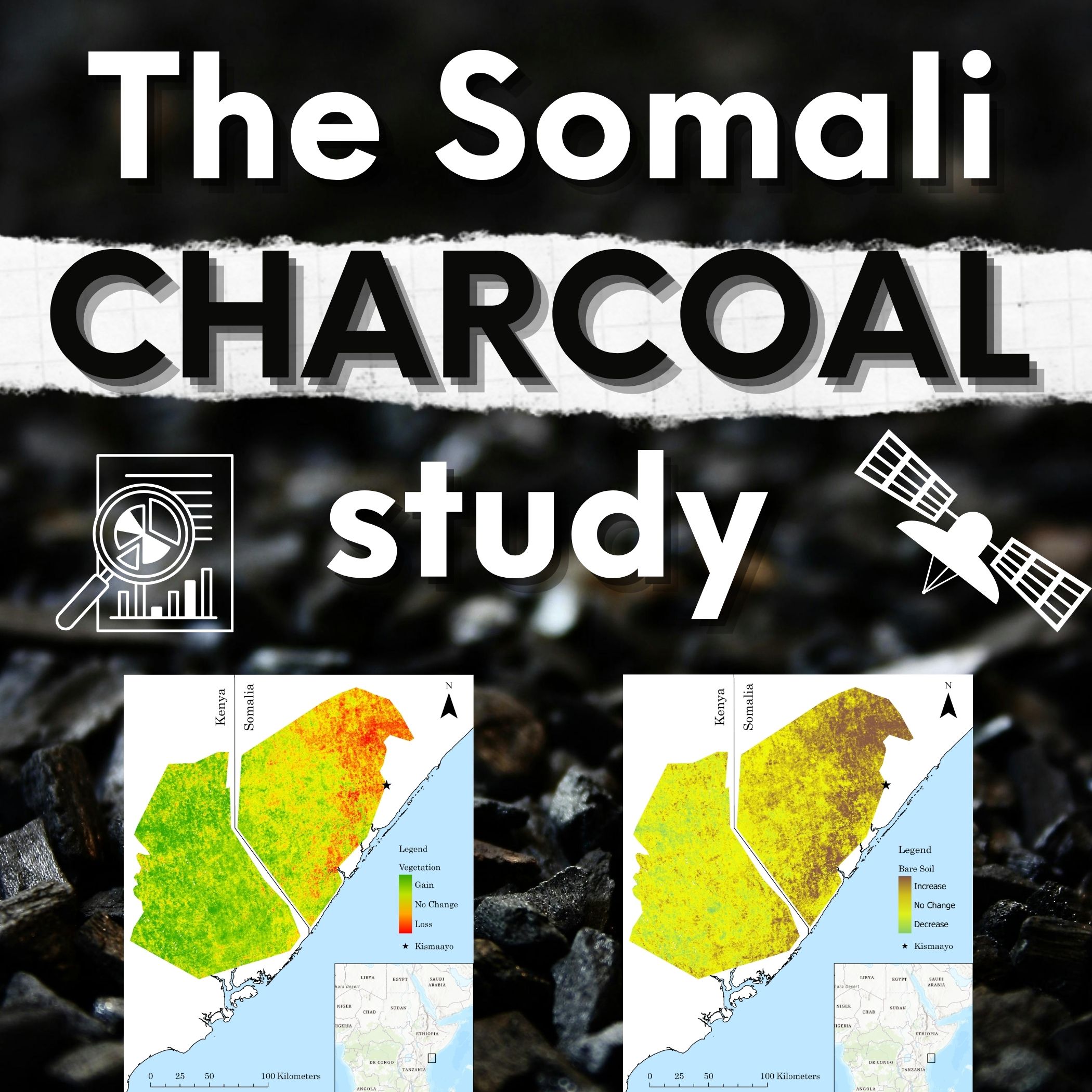
[…] In addition we are making the problem even worse – evapotranspiration decreases due to the deforestation and charcoal trade in Somalia, which will worsen the […]